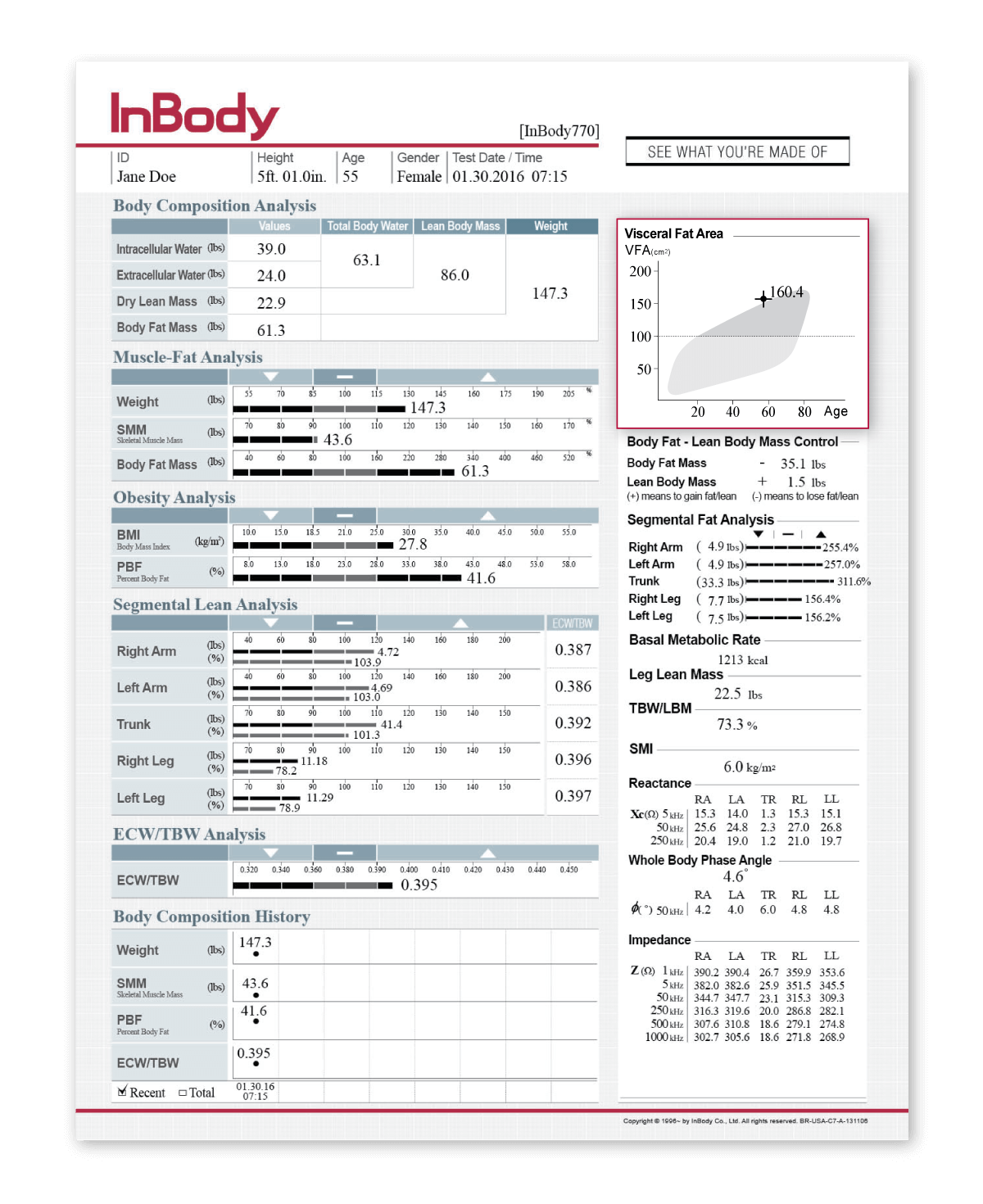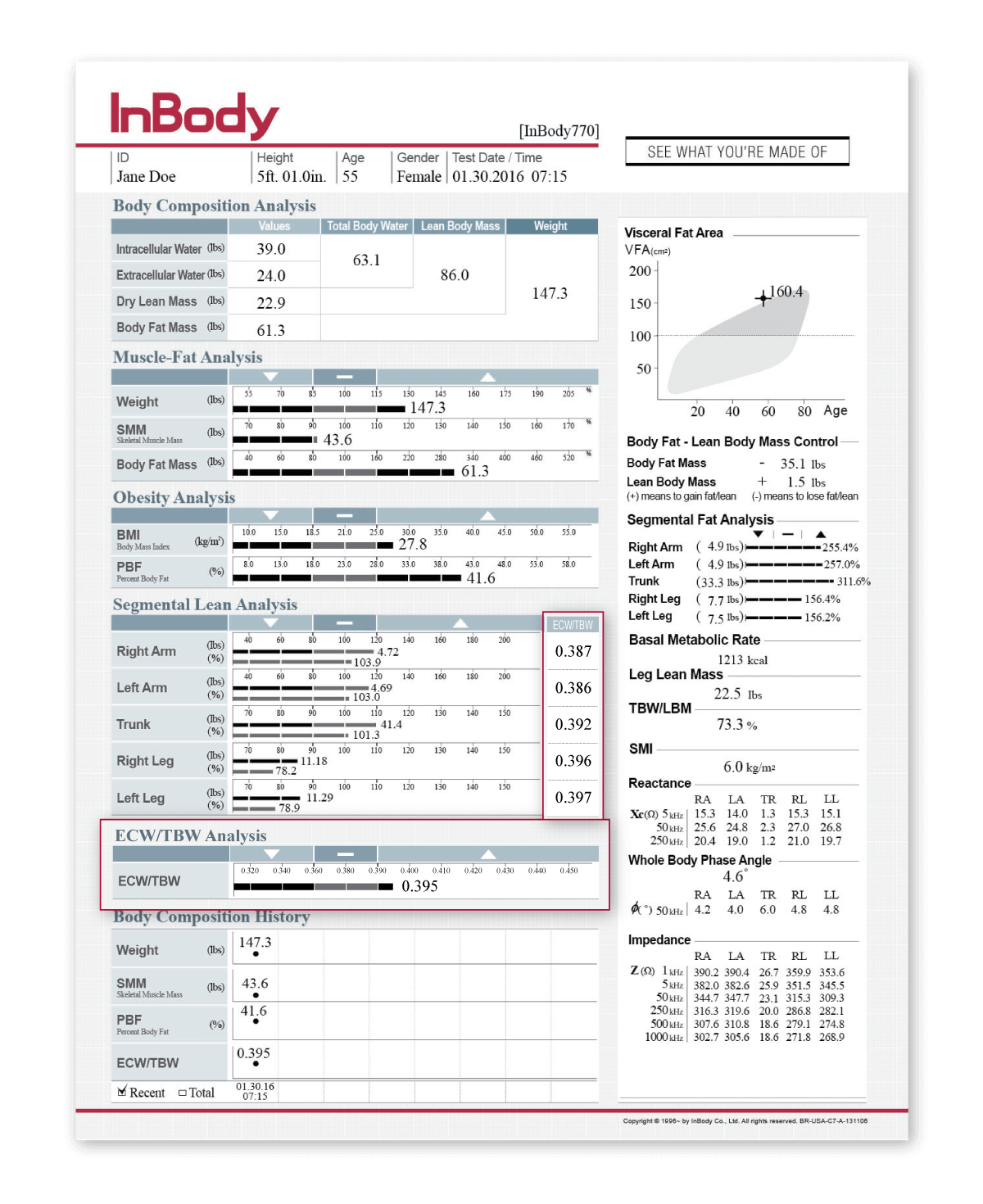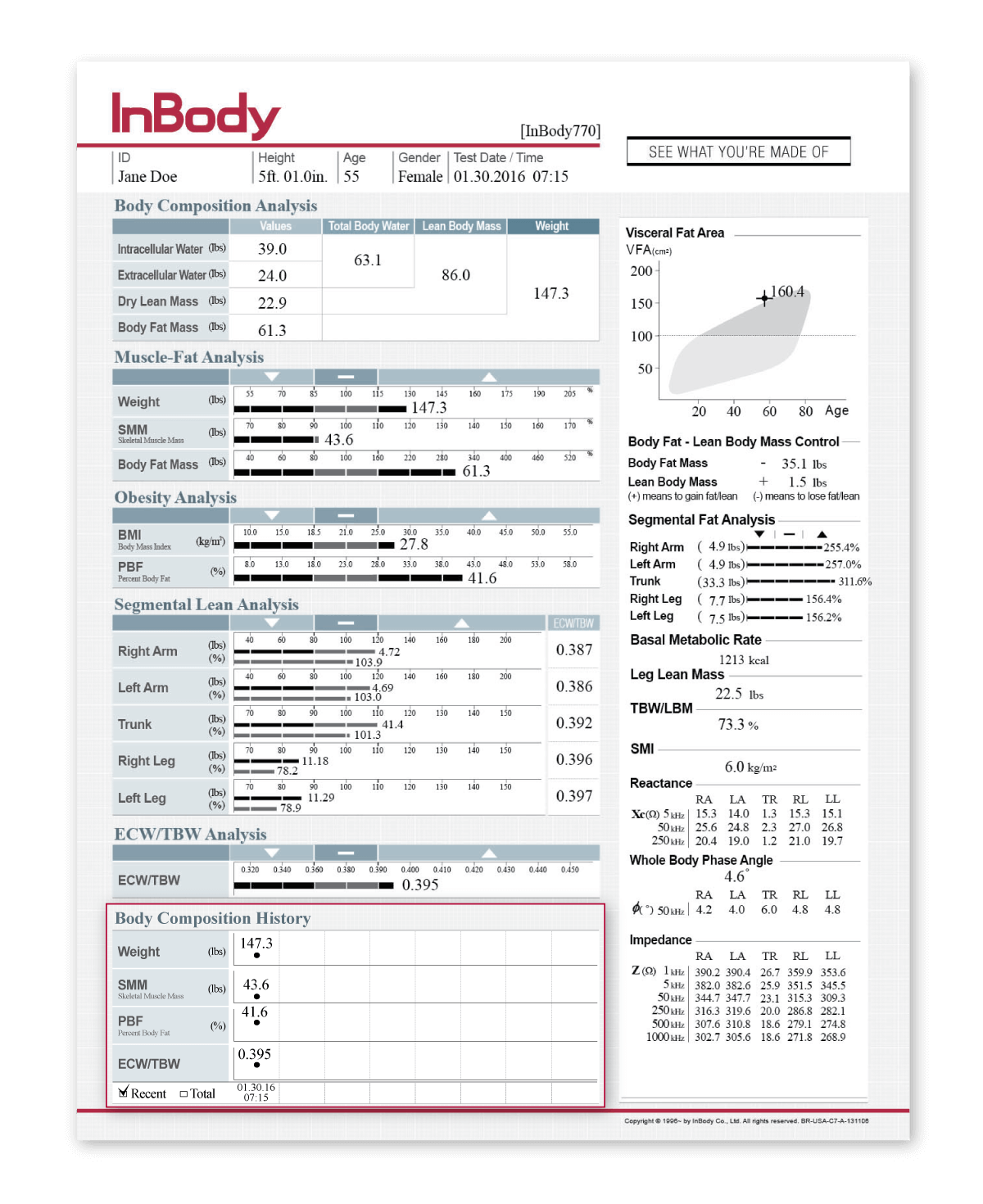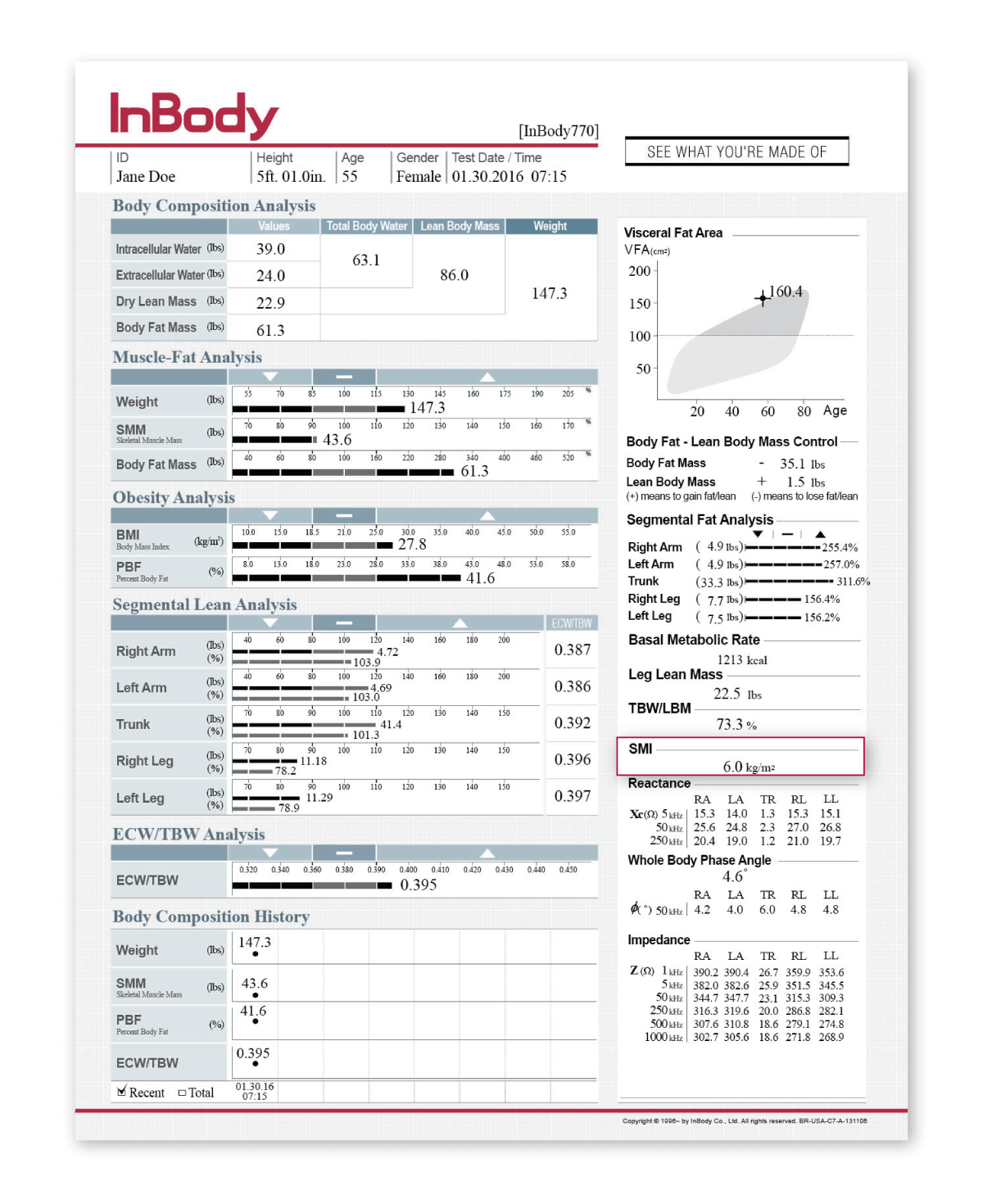
Studies have proved InBody DSM-BIA body composition analyzers are an effective tool for managing patients’ diabetic risks and symptoms. InBody products do not rely on empirical data, therefore, medical professionals can be certain the outputs generated by the device accurately reflect changes happening in the patient.
In less than 60 seconds, an InBody Test provides a comprehensive Result Sheet to help professionals:
Visceral fat plays a key role in the development of metabolic and cardiovascular disease…
diabetic peritoneal dialysis patients do appear to have increased extracellular fluid compared to their nondiabetic counterparts.
The evaluation of changes in body fat depots by bioelectrical impedance conveys additional information over changes in standard anthropometric indices…in predicting changes in the glycemic control and lipid levels in patients with type 2 diabetes.

Current methods of estimating visceral fat measures are indirect and imprecise, making them a poor tool for overall health risk assessments and long-term tracking. InBody provides a visceral fat estimate that has been linked to increased risk of hypertension, high cholesterol, and diabetes.
Waist circumference measurements serve as an indirect indicator of overall and visceral obesity; however, this method is imprecise and inadequate for monitoring changes over time. By using InBody to assess body composition, medical professionals can rely on accurate and consistent measurements to understand their patient’s risk for diabetes and/or other health conditions. As InBody’s visceral fat area is closely linked to diabetic risk, outputs including the Edema Index (ECW/TBW ratio) is also useful for tracking diabetes-related inflammation. This data will provide diabetes professionals with a better indicator for which factors may be causing health risks and set better prescriptions for change.


Diabetic risk increase is driven by both excess fat mass and low muscle mass, however, body composition methods for diabetic risk are inaccurate or inconsistent. Quantification of muscle and fat mass by region provides a more in-depth view of segmental and overall body composition and allows for better diagnosis of diabetes risk and guidance of treatment options.
Diabetes is often associated with excess fat, however having insufficient muscle mass is just as detrimental and increases diabetes risk. Leg muscles are the largest muscle group in the body and therefore serve as a driver for glucose uptake; low leg muscle mass is associated with increased risk of insulin resistance.
With InBody, medical professionals can assess and monitor a patient’s composition of muscle and fat. Outputs such Segmental Lean Mass and Leg Lean Mass provide deeper insight into the composition of leg muscle as well as the storage of fat across the body. By monitoring these factors and setting specific treatment programs to address the patient’s unique physiology, physicians and educators can track the progress and success of treatments and interventions.


Systemic inflammation caused by excess visceral fat and inflammatory hormones increase fluid retention and a patient’s risk for developing comorbidities, such as cardiovascular and renal disease. Direct and objective measures of body water can increase detection of water retention and reduce risk of secondary health conditions linked to diabetes.
By using InBody, medical professionals can track whole body ECW/TBW, a marker of inflammation and fluid imbalance, through the direct measurement of extracellular and total body water. Monitoring the Edema Index (ECW/TBW) provides an assessment of fluid accumulation in the extracellular space resulting from compromised cardiovascular function.
These measures are provided for the whole body as well as ratios specific to each segment of the arms, legs, and trunk to identify where fluid imbalances may be occurring allowing for more precise analysis and earlier indication of truncal or leg edema, aiding cardiology professionals to develop more effective fluid management strategies to improve patient outcomes.


The best way to prevent or reverse diabetes is by making healthy-focused behavioral and lifestyle changes. However, health professionals often have a hard time keeping patients engaged in a diet and exercise regimen. With a comprehensive body composition report, InBody devices show patients the changes that ordinary weight scales are incapable of showing and provide an educational outline to start a discussion towards lifestyle change. In addition, patients and providers can use the Body Composition History section to chart their progress throughout interventions and make adjustments to optimize results and health outcomes.


Diabetics patients tend to lose muscle mass. This loss in muscle mass tends to increase with the duration of diabetes, thus leading to the development of other conditions, including sarcopenia. InBody provides a skeletal muscle index (SMI) output that allows for the monitoring of skeletal muscle mass to help prevent or identify sarcopenia.
It is well known that skeletal muscle mass is important to monitor for diabetics. This results from glucose not being utilized to assist in building muscle as well as decreased physical activity causing muscle mass to deplete. This can also cause increased fatigue and further reduction of physical activity and function. The resulting decrease in muscle mass experienced by these patients increases the risk for other conditions such as sarcopenia and impaired mobility.
Sarcopenia is the loss of skeletal muscle mass, which decreases functional mobility and quality of life and increases risk of hospitalization and mortality. Sarcopenia is often associated with aging; however, it can occur in a variety of populations due to sedentary behavior or even disease. The SMI is used in order to assess and conveniently monitor skeletal muscle mass to aid in the diagnosis of sarcopenia. SMI is calculated as the sum of appendicular lean mass, normalized to height.
With the prevalence of muscle loss in diabetics and the association diabetes and sarcopenia, monitoring risk for sarcopenia in diabetics is imperative. Using the SMI output on InBody results will allow medical professionals to identify the risk of sarcopenia in easily identify increased frailty risk and promote education and intervention.


 DIRECT SEGMENTAL MEASUREMENT (DSM)
DIRECT SEGMENTAL MEASUREMENT (DSM)InBody’s Direct Segmental Measurement (DSM) technology allows for separate muscle mass and fat mass readings in each segment of the body: right arm, left arm, left leg, right leg and trunk. By measuring each segment of the body separately, the InBody is able to provide an in-depth analysis of a patient’s fluid balance for each region. These outputs include intracellular water, extracellular water and ECW/TBW ratio. Objective measures of intracellular and extracellular water can identify water retention or edema in a certain limb, which can be a precursor to diabetes.
 MULTIPLE FREQUENCIES
MULTIPLE FREQUENCIESInBody devices utilize multiple frequencies results in highly precise measures of body water. Objective measures of fluid retention and edema can now be evaluated directly rather than relying on subjective assessments like pitting or monitoring of weight change.
 8 POINT TACTILE ELECTRODES
8 POINT TACTILE ELECTRODESInBody’s advanced 8-Point Tactile Electrode system uses the placement of electrodes in relation to the anatomy of the hands and feet to ensure a consistent starting point of measurement. This enhanced reproducibility gives providers confidence in results and enables a more detailed interpretation of body composition changes in relation to recent lifestyle changes.
 NO EMPIRICAL ESTIMATIONS
NO EMPIRICAL ESTIMATIONSDiabetes patients face a unique set of health issues, and each patient must be treated based on his/her individual concerns. Because of this, InBody devices do not rely on assumptions about an individual’s age, gender or ethnicity based on empirical estimations to determine the patient’s body composition, increasing accuracy and sensitivity of test results. Therefore, diabetes professionals can be confident that the results obtained are based on the patient’s body alone and can be used to validate the efficacy of their program.

